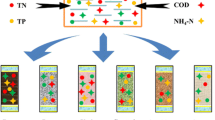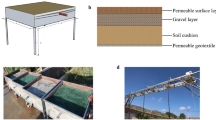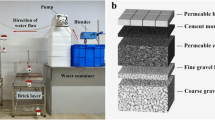Abstract
To investigate the effect of permeable pavement surface materials (PPSMs) on the influences of pollutant removal in urban storm runoff, six commonly used PPSMs (porous asphalt, porous concrete, cement brick, ceramic brick, sand base brick, and shale brick) were selected and the research was carried out by batch and column experiments. Results indicated that in batch experiments, except for the shale brick, most of the PPSM will release different pollutants continuously with the contact time increasing. Compared with other materials, porous asphalt and ceramic brick could increase the concentration of pollutants in the runoff greatly. With the contact time increased to 48 h, the concentration of NO3-N and TN increased to 13.0 and 23.1 mg/L for ceramic brick and 13.3 and 32.3 mg/L for porous asphalt, respectively. This is mainly due to the artificial activity that accelerates the wear of the PPSM. Furthermore, results showed that PPSM could eliminate pollutants and influenced the removal efficiency greatly in column experiments. Most PPSMs have a noticeable purification effect on different pollutants, among them the purification effect of porous asphalt is the best. The concentrations of COD, NH3-N, and TN are 139.6, 1.32, and 7.79 mg/L in the effluent, respectively. These results may be attributed to the relatively stable environment in column experiments which is more suitable for the removal of pollutants. This study could offer new insight into the transformation of pollutants in damaged PPSM and provide useful guidelines for the better design of permeable pavement system.

Graphical abstract







Similar content being viewed by others
References
Alzeyadi, A., Loffill, E. & Alkhaddar, R. (n.d.) A study of the physical and chemical characteristics of Ca-rich materials for use as phosphate removal filter media: a process based on laboratory-scale tests.
Angrill, S., Petit-Boix, A., Morales-Pinzón, T., Josa, A., Rieradevall, J., & Gabarrell, X. (2016). Urban rainwater runoff quantity and quality—a potential endogenous resource in cities? Journal of Environmental Management, 189, 14.
Brown, R. A., & Borst, M. (2015). Nutrient infiltrate concentrations from three permeable pavement types. Journal of Environmental Management, 164, 74–85.
China (2002). Environmental quality standards for surface water (pp. 1–9). Beijing: Chinese Environmental Protection Industry.
China (2005). Water permeable brick (pp. 1–15). Beijing: National Development and Reform Commission.
China (2009). Technical specification for pervious cement concrete pavement (pp. 1–45). Beijing: Ministry of Housing and Urban-Rural Development of the People’s Republic of China.
China (2012a). Technical specification for pavement of water permeable brick (pp. 1–44). Beijing: Ministry of Housing and Urban-Rural Development of the People’s Republic of China.
China (2012b). Technical specification for permeable asphalt pavement (pp. 1–41). Beijing: Ministry of Housing and Urban-Rural Development of the People’s Republic of China.
Chow, M. F., & Yusop, Z. (2017). Quantifying the quality and sampling time of oil and grease in urban stormwater runoff. Ksce Journal of Civil Engineering, 21, 1–9.
Drake, J., Bradford, A., & Van Seters, T. (2014). Stormwater quality of spring-summer-fall effluent from three partial-infiltration permeable pavement systems and conventional asphalt pavement. Journal of Environmental Management, 139, 69–79.
Fletcher, T. D., Deletic, A., Mitchell, V. G., & Hatt, B. E. (2008). Reuse of urban runoff in Australia: a review of recent advances and remaining challenges. Journal of Environmental Quality, 37, S116.
Gan, H., Zhuo, M., Li, D., & Zhou, Y. (2008). Quality characterization and impact assessment of highway runoff in urban and rural area of Guangzhou, China. Environmental Monitoring and Assessment, 140, 147–159.
Gnecco, I., Berretta, C., Lanza, L. G., & Barbera, P. L. (2005). Storm water pollution in the urban environment of Genoa, Italy. Atmospheric Research, 77, 60–73.
Göbel, P., Dierkes, C., & Coldewey, W. G. (2007). Storm water runoff concentration matrix for urban areas. Journal of Contaminant Hydrology, 91, 26–42.
Hou, L., & Zhang, X. (2014). Comparing urban runoff quality of a felt roof and an asphalt road in Beijing. Hydrology Research, 45, 282.
Hou, P. Q., Ren, Y. F., Wang, X. K., Ouyang, Z. Y., & Zhou, X. P. (2012). Research on evaluation of water quality of Beijing urban stormwater runoff. Environmental Science, 33, 71.
Iroumé, A., Mayen, O., & Huber, A. (2010). Runoff and peak flow responses to timber harvest and forest age in southern Chile. Hydrological Processes, 20, 37–50.
Jiang, W., Sha, A., Xiao, J., Li, Y., & Huang, Y. (2015). Experimental study on filtration effect and mechanism of pavement runoff in permeable asphalt pavement. Construction and Building Materials, 100, 102–110.
Koupai, J. A., Nejad, S. S., Mostafazadeh-Fard, S., & Behfarnia, K. (2016). Reduction of urban storm-runoff pollution using porous concrete containing iron slag adsorbent. Journal of Environmental Engineering, 142(04015072), 04015071–04015077.
Krein, A., & Schorer, M. (2000). Road runoff pollution by polycyclic aromatic hydrocarbons and its contribution to river sediments. Water Research, 34, 4110–4115.
Li, T., Dong, W. Y., Wang, H. J., Lin, J. N., Ouyang, F., & Zhang, Q. (2013). Effect of operating conditions on the chemical phosphate removal using during ferrous iron oxidation. Advanced Materials Research, 807-809, 478–485.
Li, C., Liu, M., Hu, Y., Gong, J., Sun, F., & Xu, Y. (2014). Characterization and first flush analysis in road and roof runoff in Shenyang, China. Water science and technology : a journal of the International Association on Water Pollution Research, 70, 397–406.
Li, H., Li, Z., Zhang, X., Li, Z., Liu, D., Li, T., & Zhang, Z. (2017). The effect of different surface materials on runoff quality in permeable pavement systems. Environmental Science and Pollution Research International, 24, 21103–21110.
Niu, Z. G., Lv, Z. W., Zhang, Y., & Cui, Z. Z. (2016). Stormwater infiltration and surface runoff pollution reduction performance of permeable pavement layers. Environmental Science and Pollution Research International, 23, 2576–2587.
Steenbergen, N. V., & Willems, P. (2012). Method for testing the accuracy of rainfall–runoff models in predicting peak flow changes due to rainfall changes, in a climate changing context. Journal of Hydrology s, 414–415, 425–434.
Van, R. M. (2007). Water localisation and reclamation: steps towards low impact urban design and development. Journal of Environmental Management, 83, 437–447.
Vialle, C., Sablayrolles, C., Lovera, M., Huau, M. C., Jacob, S., & Montrejaud-Vignoles, M. (2012). Water quality monitoring and hydraulic evaluation of a household roof runoff harvesting system in France. Water Resources Management, 26, 2233–2241.
Wei, Q., Zhu, G., Wu, P., Cui, L., Zhang, K., Zhou, J., & Zhang, W. (2010). Distributions of typical contaminant species in urban short-term storm runoff and their fates during rain events: a case of Xiamen City. Journal of Environmental Sciences, 22, 533–539.
Zhang, J., Hao, Z., Zhang, Z., Yang, Y., & Xu, X. (2010). Kinetics of nitrate reductive denitrification by nanoscale zero-valent iron. Process Safety & Environmental Protection, 88, 439–445.
Funding
This work was supported by the Natural Science Foundation of China (Nos. 51678025 and 51708014), the Great Scholars Program (CIT&TCD20170313), the Beijing Advanced Innovation Center of Urban Design for Future Cities: Sponge City Development and Water Quantity & Quality Risk Control (UDC2016040100), and the fifth “urban and rural construction and management” production and research graduate student training base project (No. 31061017002), the Funded by Science and Technology Plans of Ministry of Housing and Urban-Rural Development of the People’s Republic of China, and Opening Projects of Beijing Advanced Innovation Center for Future Urban Design, Beijing University of Civil Engineering and Architecture (UDC2017032922).
Author information
Authors and Affiliations
Corresponding author
Electronic Supplementary Material
ESM 1
(DOCX 1100 kb)
Rights and permissions
About this article
Cite this article
Zhang, Z., Li, Z., Zhang, X. et al. Systematically Investigated the Influences of Permeable Pavement Materials on the Water Quality of Runoff: Batch and Column Experiments. Water Air Soil Pollut 229, 155 (2018). https://doi.org/10.1007/s11270-018-3772-7
Received:
Accepted:
Published:
DOI: https://doi.org/10.1007/s11270-018-3772-7




